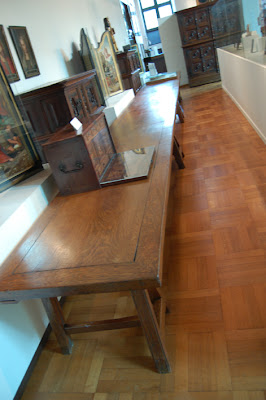Trestle tables were ubiquitous during the Middle ages, however surviving medieval trestles are very rare. I personally now only two places where surviving examples can be found. One in a museum in Paris, France, and the other in the Onze Lieve Vrouwe ter Potterie museum in Bruges, Belgium. This museum used to be a hospital during middle ages and dates from the 13th century. Among the inventory of the museum are late medieval furniture pieces, one being a very large trestle table. We visited the museum during our holiday, and took photos and measurements of the table and trestles.

This image shows the trestle table in the large hall, where it also stands today, but is moved to one of the walls. Image taken from the book "Meubles Flamands anciens" by Valentin Vermeersch.
The enormous oak table blade measures 8.4 m x 84 cm and has a thickness of 5.5 cm. I did a rough calculation on the weight of this table top and came up with a weight of around 270 kg! The table top is dated on one side with M4XXIIII or 1424. The table board is made of one piece of oak, which is enclosed by a frame. The tree for the table board must have been huge. The frame is fixed to the "main" part with dowels, that are only visible from underneath the table board. The frame is also not as long as the "main" part, and consists of two pieces fixed with a dovetail joint.

One of the short sides of the table top shows the date 1424.

The dovetail joint of the table frame. The main inner part of the table top is one piece of oak.
Underneath the table board, around the edges typical handles can be found. The use of these is unclear to me. they are fixed to the table blade with wooden dowels.

One of the handles found at the edge of the table top (long side).

Another handle at the edge of the short side of the table top.
The four oak trestles are undated but originate as well from the 15th century. They are made of stout oak beams; they have to, bearing the weight of the table top in mind. There are small differences between the four trestles in size and in the angles of the legs. I have taken measurements of only one trestle. Rough measurements of one of these trestles were also provided by Mary Ostler / Colleen Vince in a pdf handout (Making a conjecturably accurate table trestle) that can be found in the Medieval sawdust Yahoo newsgroup. While her trestle is smaller in length, the angle is the same.

Overall view of the trestle.

Side view of the trestle. Dowels can be seen in the top rail and in the single standing legs. Dowels have a diameter of 1.7 cm. You can also see that both the back and front legs have a slight angle..

Front view of the trestle. You can see the dowels in the frame of the table top,
and (two each side) at the legs at the position of the horizontal rail.

One of the centre braces was broken. This provided an excellent opportunity to see how the brace is fixed. Unfortunately I forgot to measure the depth of the groove. Brace thickness is 1 cm, groove starts at 1.4 cm from the edge.

The second trestle missing part of the brace. The back leg is straight (an angle of 90 degrees).

This photo shows the angles of the third trestle. The back leg has a negative angle of around 4 degrees, while the front legs have a positive angle of around 15 degrees (angle from top rail).

The fourth trestle, also with a straight back leg and front legs with a slight angle.

The table board is a bit twisted at the fourth trestle.
This is remedied by adding a wedge between the top rail and the table top.

You can see at the side view that the size of the top rail is actually larger than the depth of the table board. This is true for this trestle, but not for all. If you look at the photos you can see that the top rail extends behind the table top for some trestles. Measurements in the drawing are in cm.

The current display of the table in the hall of the museum.